Mechanical Response of a Buried Pipeline to Permafrost Thawing Based on Sequential Coupling Method
Abstract
:1. Introduction
2. Governing Equations and Numerical Implementation
3. Numerical Results and Analyses
3.1. Computational Domain
3.2. Boundary Conditions and Parameters
3.2.1. Boundary Condition
3.2.2. Material Parameters
3.3. Ground Temperature Distributions around the Pipeline
3.4. Mechanical Behavior of the Pipeline
4. Discussion
5. Conclusions
- (1)
- Through the comparison between the simulation results (temperatures and vertical deformation of soil specimen) and that of the experiments for one-dimensional thaw consolidation of silty clay, the sequential thermo-mechanical coupling method is proved to be reliable for the prediction of the thaw settlement and consolidation of degrading permafrost under the periodic boundary condition.
- (2)
- The buried pipeline would cause significant disturbance to the temperature field around it, characterized by isotherm shape changing, permafrost table deepening, seasonal frost penetration decreasing, and resultant thaw bulb expanding. In the 10–15 years after pipeline construction, the thawing front beneath the pipeline extended to the weathered granite layer, which had a small deformation after thaw and warming. The permafrost table depth beneath the center of the pipeline increased in the form of a power function as the operation time of the pipeline increased.
- (3)
- Pipeline settlement increased with the thawing of foundation permafrost and then kept almost unchanged when the thawing front entered into the weathered granite. Differential settlement of degrading permafrost would cause oval-shaped high-stress areas on the buried pipeline near the interface of strong and weak thaw settlement zones. When the length ratio of strong and weak thaw settlement zones is 1, the maximum stress of the pipeline with a thickness of 16 mm was approximately 45% of its allowable stress, and the pipeline remained safe for 30 years. We expect that the stress exerted on the pipeline will increase larger than previously estimated, owing mainly to the underestimated permafrost degradation and permafrost-thaw-related movement of soil mass. A fully coupled numerical model of interaction between the pipeline and permafrost thawing needs to be established to evaluate more carefully the structural integrity of the warm pipeline buried in frozen soils.
Author Contributions
Funding
Institutional Review Board Statement
Informed Consent Statement
Data Availability Statement
Acknowledgments
Conflicts of Interest
References
- Karamitros, D.K.; Bouckovalas, G.D.; Kouretzis, G.P. Stress analysis of buried steel pipelines at strike-slip fault crossings. Soil Dyn. Earthq. Eng. 2007, 27, 200–211. [Google Scholar] [CrossRef]
- Karamitros, D.K.; Bouckovalas, G.D.; Kouretzis, G.P.; Gkesouli, V. An analytical method for strength verification of buried steel pipelines at normal fault crossings. Soil Dyn. Earthq. Eng. 2011, 31, 1452–1464. [Google Scholar] [CrossRef]
- Geertsema, M.; Schwab, J.W.; Blais-Stevens, A.; Sakals, M.E. Landslides impacting linear infrastructure in west central British Columbia. Nat. Hazards 2009, 48, 59–72. [Google Scholar] [CrossRef]
- Yuan, F.; Wang, L.Z.; Guo, Z.; Xie, Y.G. A refined analytical model for landslide or debris flow impact on pipelines–Part II: Embedded pipelines. Appl. Ocean Res. 2012, 35, 105–114. [Google Scholar] [CrossRef]
- Wang, Y.; Shi, J.W.; Ng, C.W.W. Numerical modeling of tunneling effect on buried pipelines. Can. Geotech. J. 2011, 48, 1125–1137. [Google Scholar] [CrossRef]
- Kouretzis, G.P.; Karamitros, D.K.; Sloan, S.W. Analysis of buried pipelines subjected to ground surface settlement and heave. Can. Geotech. J. 2014, 52, 1058–1071. [Google Scholar] [CrossRef]
- Zhang, J.; Liang, Z.; Zhao, G. Mechanical behaviour analysis of a buried steel pipeline under ground overload. Eng. Fail. Anal. 2016, 63, 131–145. [Google Scholar] [CrossRef]
- Yu, C.; Han, C.J.; Xie, R.; Wang, L. Mechanical behavior analysis of buried pipeline under stratum settlement caused by underground mining. Int. J. Pres. Ves. Pip. 2020, 188, 104212. [Google Scholar] [CrossRef]
- Razaqpur, A.G.; Wang, D. Frost-induced deformations and stresses in pipelines. Int. J. Pres. Ves. Pip. 1996, 69, 105–118. [Google Scholar] [CrossRef]
- Rajeev, P.; Kodikara, J. Numerical analysis of an experimental pipe buried in swelling soil. Comput. Geotech. 2011, 38, 897–904. [Google Scholar] [CrossRef]
- Xu, G.Q.; Luo, Y.; Yao, B.; Jiang, W.C. Stresses measurement and failure prevention of on-line natural gas transmission pipelines for compressor station on collapsible loess area in northwest China. Eng. Fail. Anal. 2021, 126, 105467. [Google Scholar] [CrossRef]
- Carlson, L.E.; Ellwood, J.R.; Nixon, J.F.; Slusarch, W.A. Field test results of operating a chilled, buried pipeline in unfrozen ground. In Proceedings of the 4th Canadian Permafrost Conference, Calgary, AB, Canada, 2–6 March 1982; pp. 475–480. [Google Scholar]
- Nixon, J.F.; Burgess, M. Norman Wells pipeline settlement and uplift movements. Can. Geotech. J. 1999, 36, 119–135. [Google Scholar] [CrossRef]
- Smith, S.L.; Burgess, M.M.; Riseborough, D.W. Ground temperature and thaw settlement in frozen peatlands along the Norman Wells pipeline corridor, NWT Canada: 22 years of monitoring. In Proceedings of the 9th International Conference on Permafrost, Fairbanks, AK, USA, 29 June–3 July 2008; pp. 1665–1670. [Google Scholar]
- Hwang, C.T. On quasi-static solutions for buried pipes in permafrost. Can. Geotech. J. 1977, 14, 180–192. [Google Scholar] [CrossRef]
- Lachenbruch, A.H. Some Estimates of the Thermal Effects of A Heated Pipeline in Permafrost; US Geological Survey: Reston, VA, USA, 1970. [Google Scholar]
- Mu, Y.H.; Li, G.Y.; Ma, W.; Song, Z.M.; Zhou, Z.W.; Wang, F. Rapid permafrost thaw induced by heat loss from a buried warm-oil pipeline and a new mitigation measure combining seasonal air-cooled embankment and pipe insulation. Energy 2020, 203, 117919. [Google Scholar]
- Chen, L.; Yu, W.B.; Lu, Y.; Wu, P.; Han, F.L. Characteristics of heat fluxes of an oil pipeline armed with thermosyphons in permafrost regions. Appl. Therm. Eng. 2021, 190, 116694. [Google Scholar] [CrossRef]
- Wang, F.; Li, G.Y.; Ma, W.; Chen, D.; Wu, G.; Cao, Y.P.; Mu, Y.H.; Mao, Y.C.; Zhang, J.; Gao, K.; et al. Assessment of permafrost disturbances caused by two parallel buried warm-oil pipelines: A case study at a high-latitude wetland site in Northeast China. Cold Reg. Sci. Technol. 2023, 206, 103753. [Google Scholar] [CrossRef]
- Huang, S.L.; Bray, M.T.; Akagawa, S.; Fukada, M. Field investigation of soil heave by a large diameter chilled gas pipeline experiment, Fairbanks, Alaska. J. Cold Reg. Eng. 2004, 18, 2–34. [Google Scholar] [CrossRef]
- Wang, F.; Li, G.Y.; Ma, W.; Wu, Q.B.; Serban, M.; Vera, S.; Fedorov, A.; Jiang, N.S.; Wang, B. Pipeline–permafrost interaction monitoring system along the China–Russia crude oil pipeline. Eng. Geol. 2019, 254, 113–125. [Google Scholar] [CrossRef]
- Li, G.Y.; Ma, W.; Wang, F.; Jin, H.J.; Fedorov, A.; Chen, D.; Wu, G.; Cao, Y.P.; Zhou, Y.; Mu, Y.H.; et al. A newly integrated ground temperature dataset of permafrost along the China–Russia crude oil pipeline route in Northeast China. Earth Syst. Sci. Data 2022, 14, 5093–5110. [Google Scholar] [CrossRef]
- Carlson, L.E.; Nixon, J.F. Subsoil investigation of ice lensing at the Calgary, Canada, frost heave test facility. Can. Geotech. J. 1988, 25, 307–319. [Google Scholar] [CrossRef]
- Rajani, B.; Morgenstern, N. Comparison of predicted and observed responses of pipeline to differential frost heave. Can. Geotech. J. 1994, 31, 803–816. [Google Scholar] [CrossRef]
- Konrad, J.M.; Morgenstern, N.R. Frost heave prediction of chilled pipelines buried in unfrozen soils. Can. Geotech. J. 1984, 21, 100–115. [Google Scholar] [CrossRef] [Green Version]
- Selvadurai, A.P.S.; Hu, J.; Konuk, I. Computational modelling of frost heave induced soil–pipeline interaction: II. Modelling of experiments at the Caen test facility. Cold Reg. Sci. Technol. 1999, 29, 229–257. [Google Scholar] [CrossRef]
- Kim, K.; Zhou, W.; Huang, S.L. Frost heave predictions of buried chilled gas pipelines with the effect of permafrost. Cold Reg. Sci. Technol. 2008, 53, 382–396. [Google Scholar] [CrossRef]
- Li, H.W.; Lai, Y.M.; Wang, L.Z.; Yang, X.S.; Jiang, N.S.; Li, L.; Wang, C.; Yang, B.C. Review of the state of the art: Interactions between a buried pipeline and frozen soil. Cold Reg. Sci. Technol. 2019, 157, 171–186. [Google Scholar] [CrossRef]
- Wang, F.; Li, G.Y.; Ma, W. Progress in the research on the thermo-mechanical interaction between oil pipeline and permafrost in cold regions. J. Glaciol. Geocryol. 2022, 44, 217–228. [Google Scholar]
- Wen, Z.; Sheng, Y.; Jin, H.J.; Li, S.Y.; Li, G.Y.; Niu, Y.H. Thermal elasto-plastic computation model for a buried oil pipeline in frozen ground. Cold Reg. Sci. Technol. 2010, 64, 248–255. [Google Scholar] [CrossRef]
- Zhou, J.W.; Liang, Z.; Zhang, L.; Zheng, T.; Zheng, J.Y. Thermal and mechanical analysis of the China–Russia Crude Oil Pipeline suffering settlement disaster in permafrost regions. Int. J. Pres. Ves. Pip. 2022, 199, 104729. [Google Scholar] [CrossRef]
- Xie, R.; Zhang, J. Mechanical behavior of buried pipeline crossing thaw settlement zone. J. Pres. Ves. Tech. 2022, 144, 041902. [Google Scholar] [CrossRef]
- Wei, X.C.; Niu, Z.Y.; Li, Q.; Ma, J.L. Potential failure analysis of thawing-pipeline interaction at fault crossing in permafrost. Soil Dyn. Earthq. Eng. 2018, 106, 31–40. [Google Scholar] [CrossRef]
- Streletskiy, D.; Anisimov, O.; Vasiliev, A. Permafrost degradation. In Snow and Ice-Related Hazards, Risks and Disasters; Elsevier: Amsterdam, The Netherlands, 2005; pp. 303–344. [Google Scholar]
- Watson, G.H.; Rowley, R.K.; Slusarchuk, W.A. Performance of a warm oil pipeline buried in permafrost. In Proceedings of the 2nd International Conference on Permafrost, Yakutsk, Soviet Union, 13–28 July 1973; pp. 759–766. [Google Scholar]
- Wang, F.; Li, G.Y.; Alexander, F.; Ma, W.; Chen, D.; Wu, G.; Mu, Y.H.; Wang, X.B.; Jing, H.Y.; Zhang, Z.R. Applicability analysis of thermosyphon for thermally stabilizing pipeline foundation permafrost and its layout optimization. Cold Reg. Sci. Technol. 2023, 208, 103769. [Google Scholar] [CrossRef]
- Huang, Y.T. Laboratory Research on Consolidation Deformation Mechanism and Pore Water Pressure Dissipation within Thawing Soil. Ph.D. Thesis, University of Chinese Academy of Sciences, Beijing, China, 2021. [Google Scholar]
- Ma, W.; Wang, D.Y. Frozen Soil Mechanics; Science Press: Beijing, China, 2014. [Google Scholar]
- Chen, L.; Yu, W.B.; Zhang, T.Q.; Yi, X. Asymmetric talik formation beneath the embankment of Qinghai-Tibet Highway triggered by the sunny-shady effect. Energy 2023, 266, 126472. [Google Scholar] [CrossRef]
- Ming, F.; Yu, Q.H.; Li, D.Q. Investigation of embankment deformation mechanisms in permafrost regions. Transp. Geotech. 2018, 16, 21–28. [Google Scholar] [CrossRef]
- Xu, X.Z.; Wang, J.C.; Zhang, L.X. Physics of Frozen Soil; Science Press: Beijing, China, 2001. [Google Scholar]
- Yao, X.L.; Qi, J.L.; Wu, W. Three dimensional analysis of large strain thaw consolidation in permafrost. Acta Geotech. 2012, 7, 193–202. [Google Scholar] [CrossRef]
- Li, C.J.; Jiang, M.Z.; Ji, G.F. Thermal-stress computation of the buried heated-oil pipeline in permafrost regions. J. Southwest Petrol. Inst. 2000, 22, 77–79. [Google Scholar]
- Li, S.Y.; Lai, Y.M.; Zhang, M.Y.; Dong, Y.H. Study on long-term stability of Qinghai–Tibet Railway embankment. Cold Reg. Sci. Technol. 2009, 57, 139–147. [Google Scholar] [CrossRef]
- Han, F.L.; Yu, W.B.; Ma, L.X.; Yi, X.; Zhang, X.F. Heat transfer and cold energy capacity properties of crushed-rock layer in cold sandy regions. Int. J. Therm. Sci. 2023, 189, 108286. [Google Scholar] [CrossRef]
- Pei, W.S.; Zhang, M.Y.; Li, S.Y.; Lai, Y.M.; Jin, L. Thermo-mechanical stability analysis of cooling embankment with crushed-rock interlayer on a sloping ground in permafrost regions. Appl. Therm. Eng. 2017, 125, 1200–1208. [Google Scholar] [CrossRef]
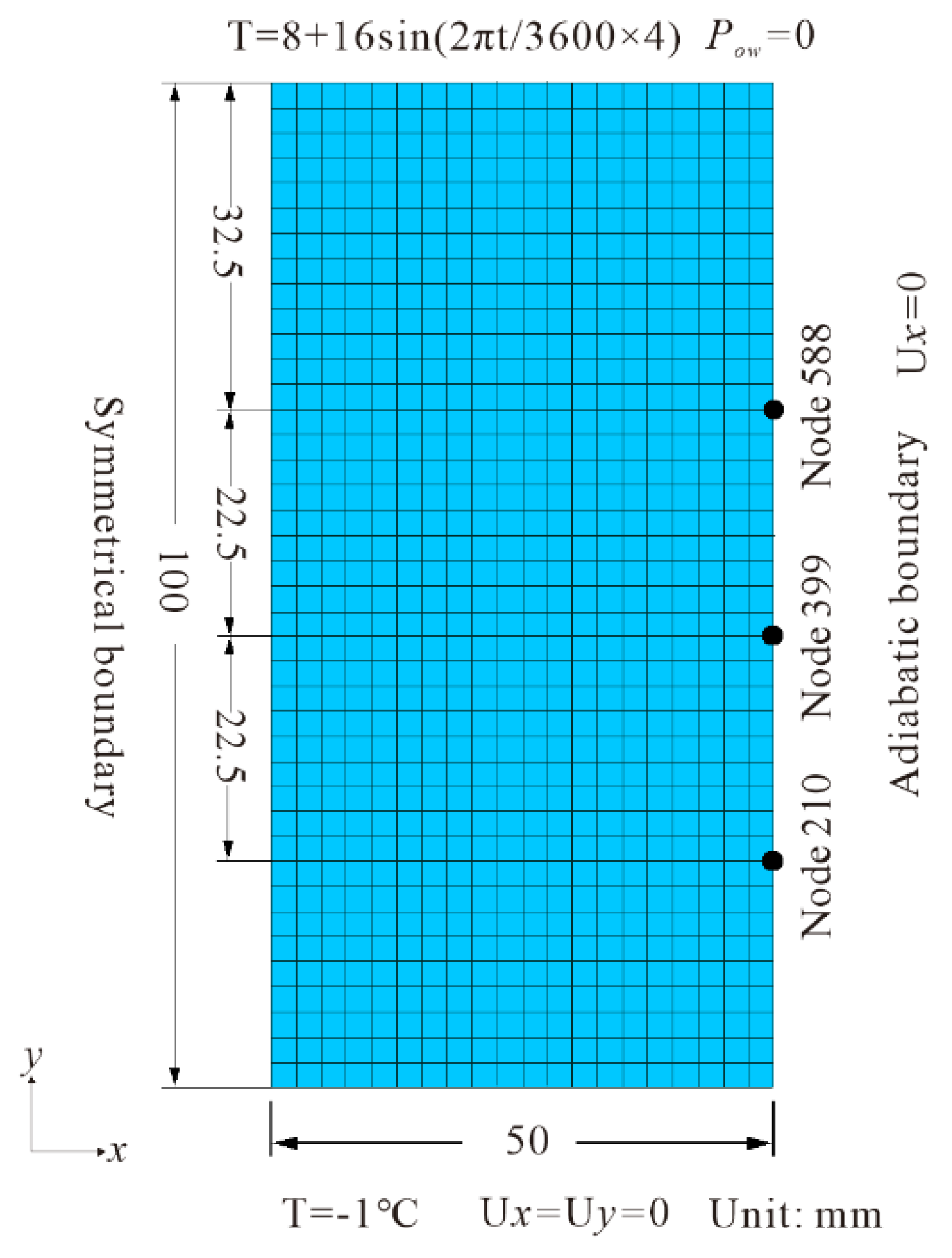

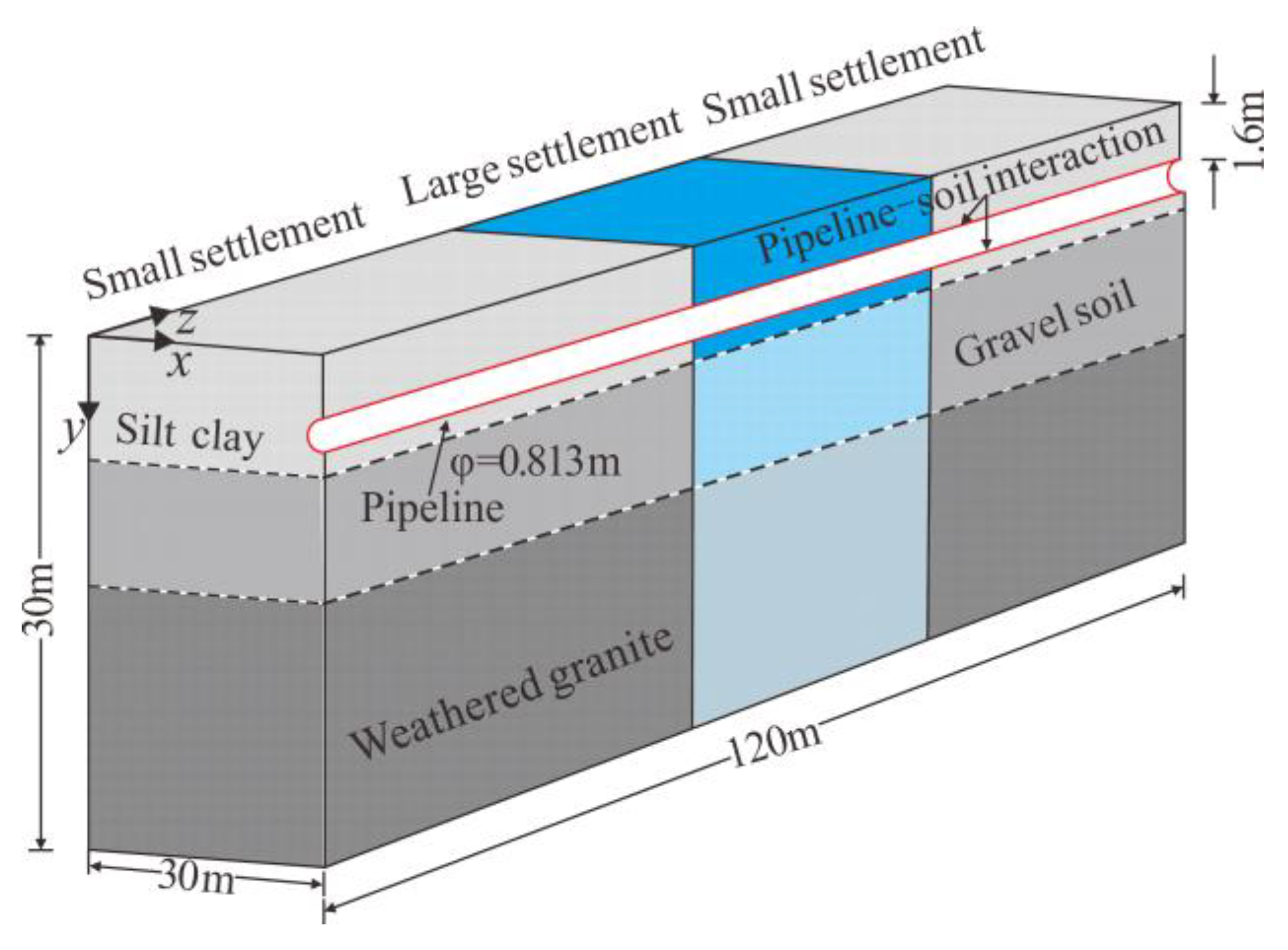

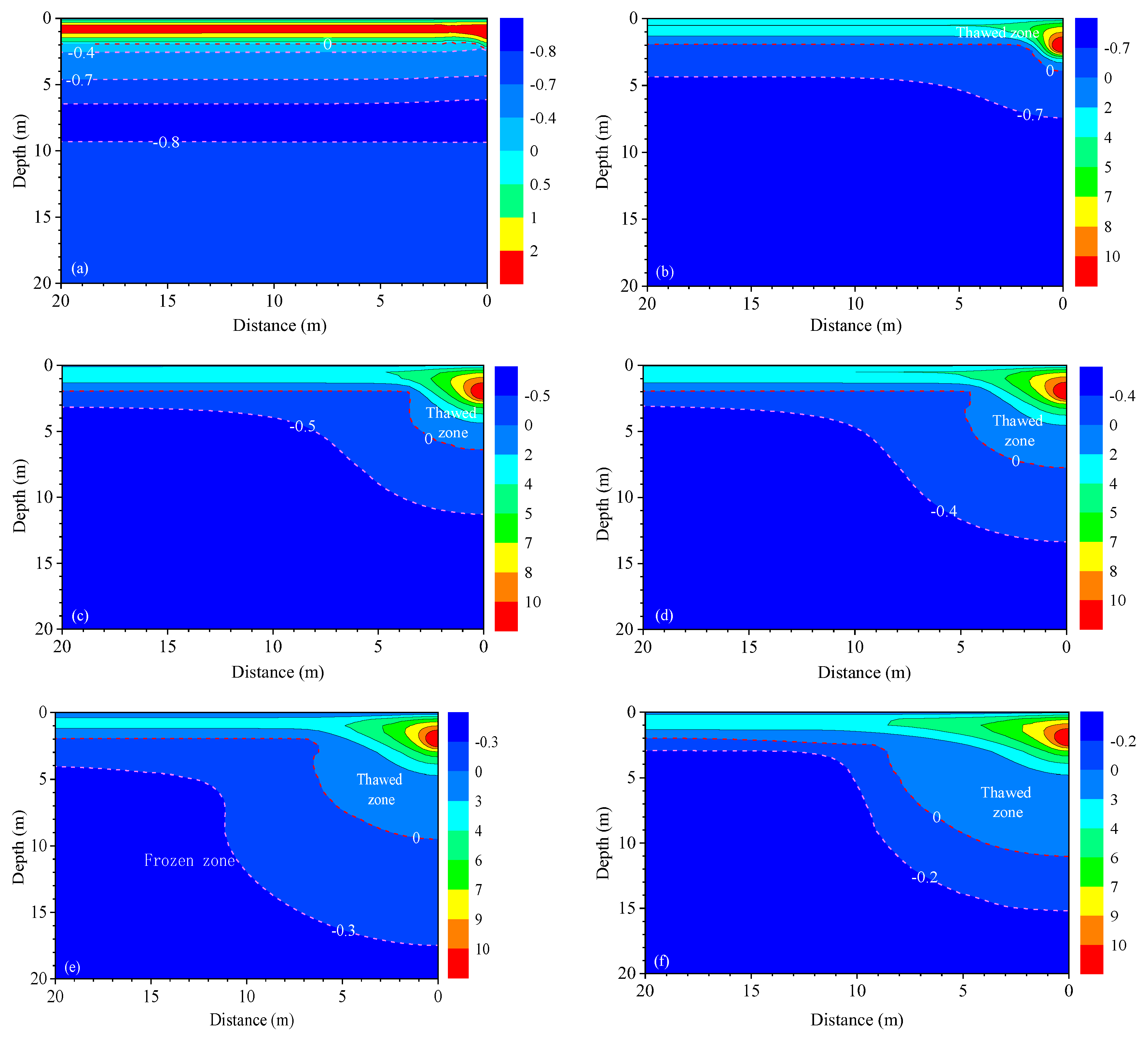
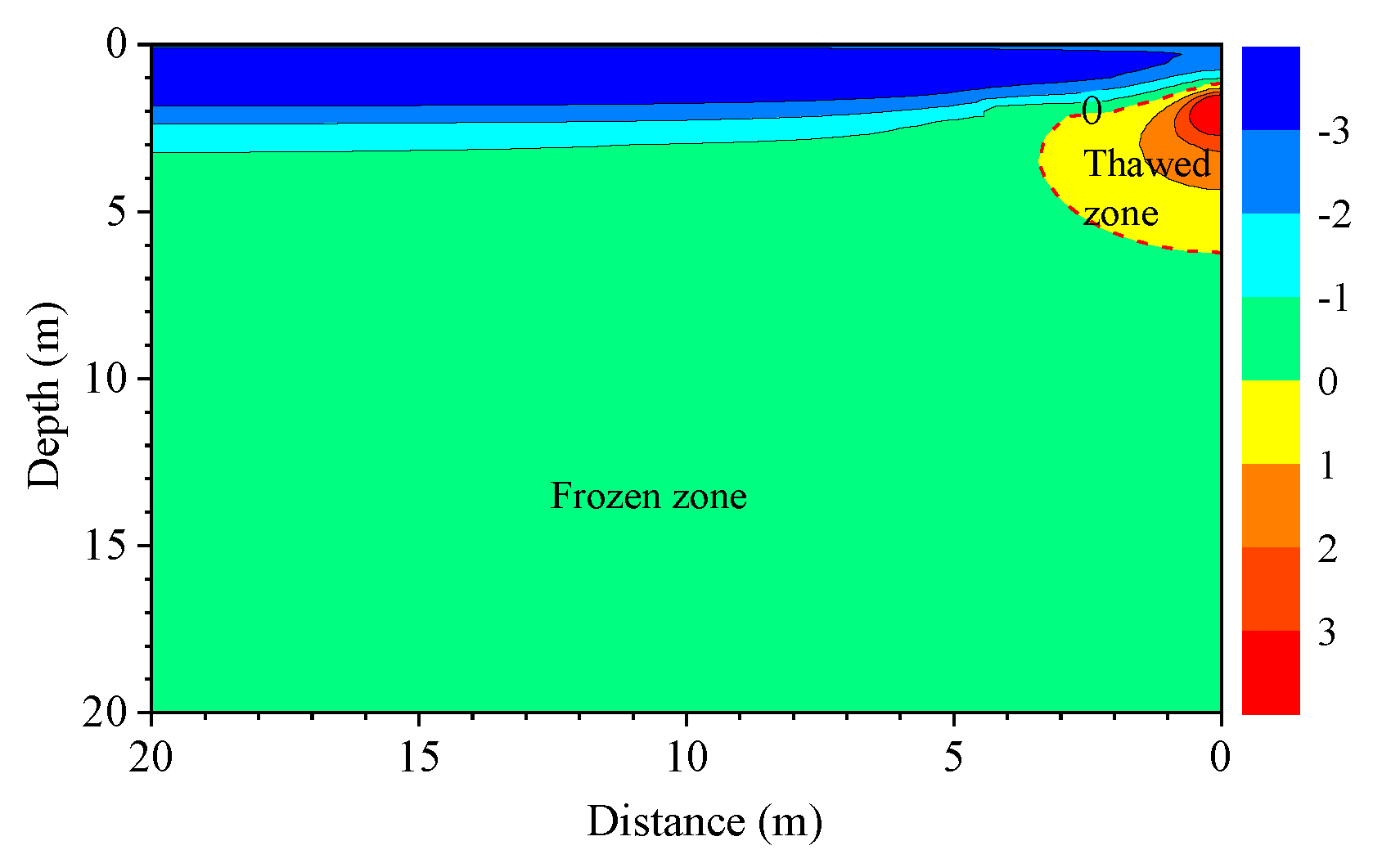
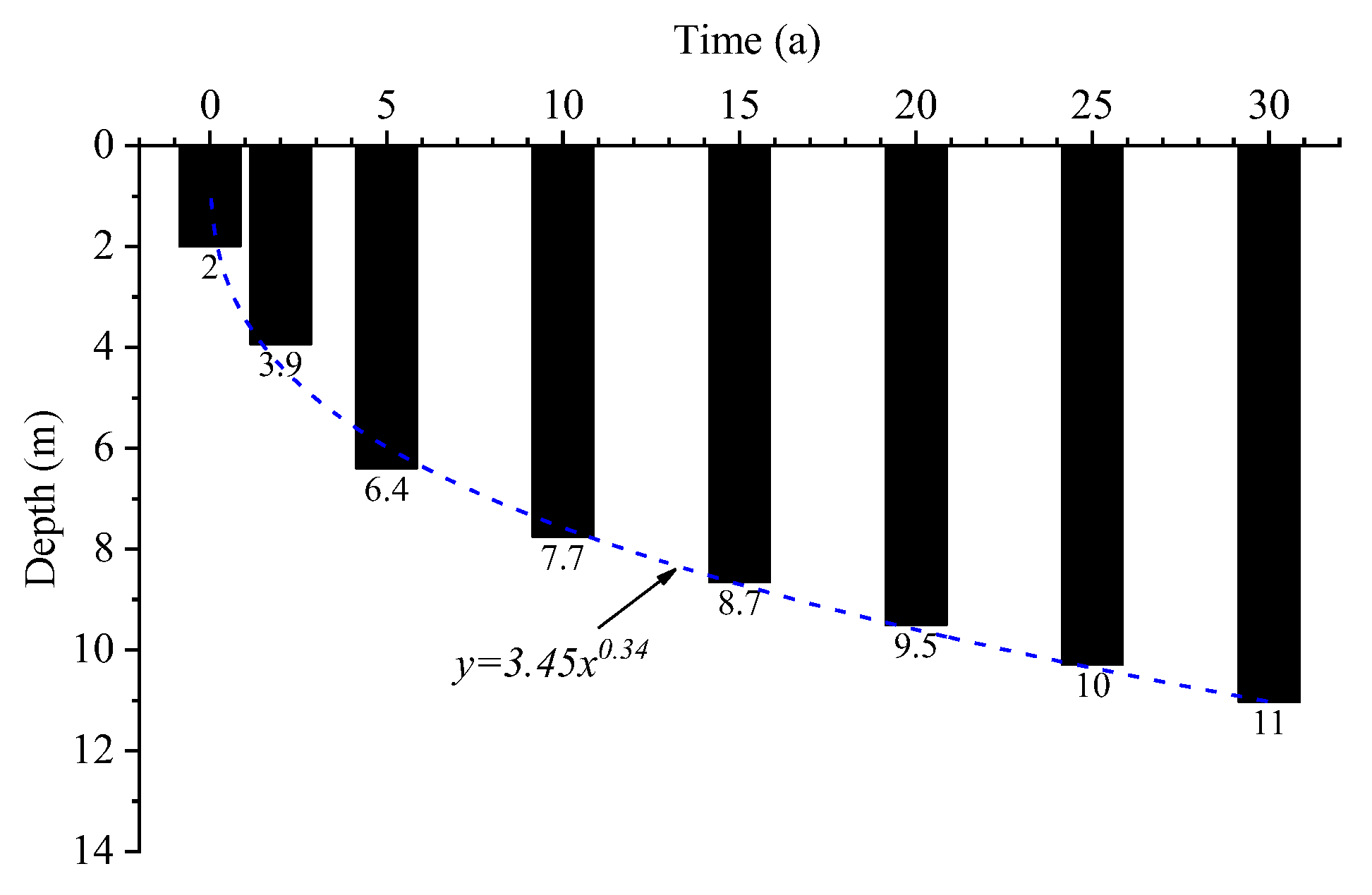
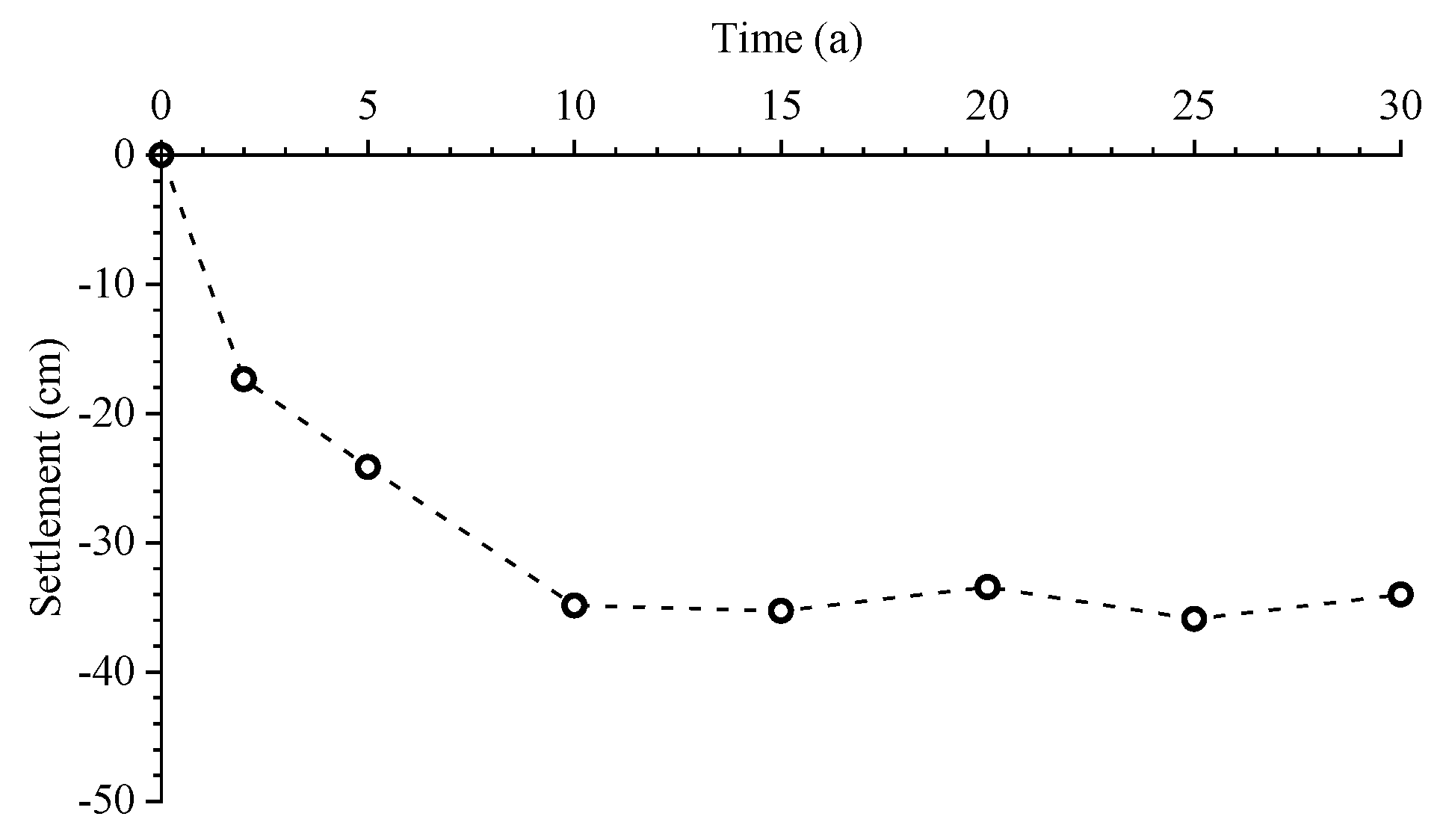


| λ (W·m−1·°C−1) | C (J·m−3·°C−1) | L (J·m−3) | E (MPa) | μ | k (m·s−1) | |||
|---|---|---|---|---|---|---|---|---|
| λ f | λ u | Cf | Cu | Ef | Eu | |||
| 2.14 | 1.42 | 1.772 × 106 | 2.332 × 106 | 2.958 × 107 | 3.0 | 0.55 | 0.3 | 1 × 10−8 |
| Material | /(W·m−1·°C−1) | /(J·m−1·°C−1) | /(J·m−1) | ||
|---|---|---|---|---|---|
| λu | λf | Cu | Cf | ||
| Silt clay | 0.78 | 0.82 | 2.54 × 106 | 2.01 × 106 | 6.03 × 107 |
| Silt clay * | 0.76 | 0.76 | 2.87 × 106 | 2.05 × 106 | 3.77 × 107 |
| Gravel soil | 1.15 | 1.30 | 2.03 × 106 | 1.56 × 106 | 2.32 × 107 |
| Gravel soil * | 1.10 | 1.20 | 2.14 × 106 | 1.48 × 106 | 1.89 × 107 |
| Weathered granite | 1.68 | 1.81 | 3.42 × 106 | 2.70 × 106 | 3.77 × 107 |
| Pipeline | 48 | 3.65 × 106 | |||
| Material | (MPa) | (MPa) | (°) | (m·h−1) | |||||
|---|---|---|---|---|---|---|---|---|---|
| Silt clay Silt clay * | 3 5 | 0.15 0.75 | 0.32 | 0.35 | 0.6 1.3 | 0.02 0.05 | 26 | 24 | 3.6 × 10−4 4.5 × 10−5 |
| Gravel soil Gravel soil * | 30 100 | 2 40 | 0.25 | 0.3 | 0.10 0.21 | 0.03 0.07 | 42 | 40 | 2.6 × 10−4 2.2 × 10−5 |
| Weathered granite | 200 | 20 | 0.2 | 0.25 | 0.34 | 0.10 | 20 | 18 | 1.8 × 10−6 |
| Weathered granite * | 300 | 140 | 1.8 × 10−7 | ||||||
Disclaimer/Publisher’s Note: The statements, opinions and data contained in all publications are solely those of the individual author(s) and contributor(s) and not of MDPI and/or the editor(s). MDPI and/or the editor(s) disclaim responsibility for any injury to people or property resulting from any ideas, methods, instructions or products referred to in the content. |
© 2023 by the authors. Licensee MDPI, Basel, Switzerland. This article is an open access article distributed under the terms and conditions of the Creative Commons Attribution (CC BY) license (https://creativecommons.org/licenses/by/4.0/).
Share and Cite
Wang, F.; Wu, G.; Chen, D.; Li, G.; Qian, Y.; Xi, F.; Wang, L. Mechanical Response of a Buried Pipeline to Permafrost Thawing Based on Sequential Coupling Method. Atmosphere 2023, 14, 620. https://doi.org/10.3390/atmos14040620
Wang F, Wu G, Chen D, Li G, Qian Y, Xi F, Wang L. Mechanical Response of a Buried Pipeline to Permafrost Thawing Based on Sequential Coupling Method. Atmosphere. 2023; 14(4):620. https://doi.org/10.3390/atmos14040620
Chicago/Turabian StyleWang, Fei, Gang Wu, Dun Chen, Guoyu Li, Yulong Qian, Feilong Xi, and Ling Wang. 2023. "Mechanical Response of a Buried Pipeline to Permafrost Thawing Based on Sequential Coupling Method" Atmosphere 14, no. 4: 620. https://doi.org/10.3390/atmos14040620
APA StyleWang, F., Wu, G., Chen, D., Li, G., Qian, Y., Xi, F., & Wang, L. (2023). Mechanical Response of a Buried Pipeline to Permafrost Thawing Based on Sequential Coupling Method. Atmosphere, 14(4), 620. https://doi.org/10.3390/atmos14040620






